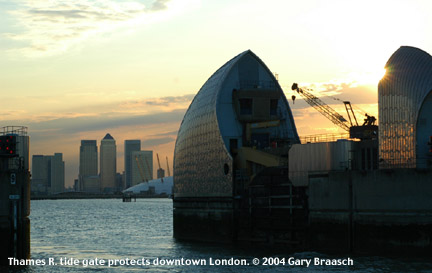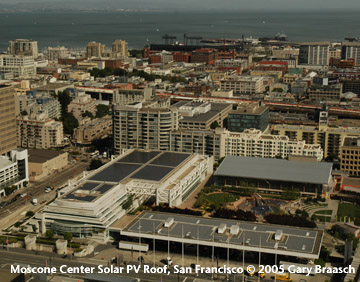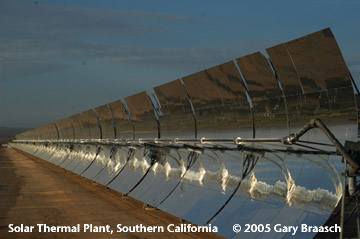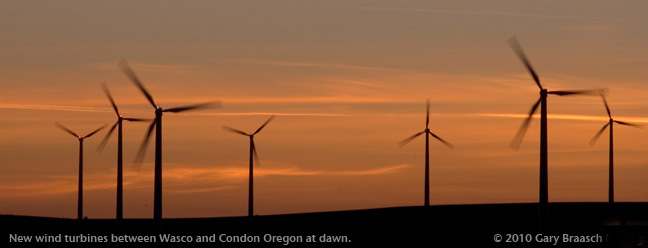Technologies to Combat Global Warming
Engineers report plenty of technology available to stem greenhouse gases
September 2011
The technology needed to cut the world's greenhouse gas emissions by 85 percent by 2050 already exists, according to a joint statement by eleven of the world's largest engineering organizations.
The groups listed generating electricity from wind, waves and the sun, growing biofuels sustainably, zero emissions transport, low carbon buildings and energy efficiency technologies among the tools already demonstrated. However the report warmed these technologies are not being developed for wide-scale use fast enough. The report highlighted a need for financial and legislative support from governments around the world if new energy sources and efficiencies are to fulfill their potential. "We are now overdue for government commitment," said a spokesman for the engineers, Dr Colin Brown, "with ambitious, concrete emissions targets that give the right signals to industry, so they can be rolled out on a global scale."
The engineering societies, which represent more than a million engineers from four continents, asked for action and commitments at the upcoming Durban UN climate talks:
A global commitment at Durban to a peak in greenhouse gas emissions by 2020, followed by substantial reductions by 2050;
Governments to ensure that green policies do not unfairly and unintentionally act to the detriment of one particular industry or country;
Intensive effort to train and retrain workforces to ensure we have the right skills for the new industries that will spring up around green technologies;
A heavier emphasis to be placed on boosting energy efficiency, which is the best available measure to bring down emissions in the short and medium term.
Other groups and agencies have also seen that technologies and processes exist now to hugely reduce greenhouse gas emissions. One group of reports was documented in Earth Under Fire, and included:
American Solar Energy Society, "Tackling Climate Change in the U.S.," www.ases.org/climatechange.
Europa, European Union's strategy for climate change, http://ec.europa.eu/environment/climat/future_action.htm.
Greenpeace, "Energy Revolution: A Sustainable Pathway to a Clean Energy Future for Europe," www.greenpeace.org/international/press/reports/energy-revolution-a-sustainab.pdf.
National Commission on Energy Policy, "Ending the Energy Stalemate," report of a three-year effort to develop consensus recommendations for US energy policy,
www.energycommission.org/site/page.php?report=13.
Princeton Environmental Institute, Carbon Mitigation Initiative, a joint project of Princeton University, BP, and Ford Motor Company (including the "Stabilization Wedge"
approach), www.princeton.edu/~cmi.
Rocky Mountain Institute, proposals for market-based, profitable measures to reduce greenhouse emissions,
www.rmi.org.
Set America Free Coalition, "Blueprint for US Energy Security," www.setamericafree.org.
"Smarter Living," a Swiss proposal for sustainable development centered on the "2000-watt society," www.novatlantis.ch/pdf/leichterleben_eng.pdf.
US Department of Energy, Office of Energy Efficiency and Renewable Energy, "Scenarios for a Clean Energy Future," www.ornl.gov/sci/eere/cef.
Worldwatch Institute and Center for American Progress, "The Renewable Path to Energy Security," a report of the American Energy Initiative, www.americanenergynow.org.

Increasingly nations and governments have been adopting technologies to deal with global warming. Some large installations are strictly defensive, like the Thames River Barrier protecting London, built beginning in 1982. At first it was used rarely, less than once a year, but British Science Advisor Sir David King says it is now closed against high tides 6 or 7 times a year.
Wind turbines are being installed worldwide at an increasing rate. Wind is the fastest growing energy technology in the world today. In recent years, wind capacity worldwide has more than doubled. The towers must be located to protect migrating birds and bats, and scenic landscapes -- which unfortunately early wind farms like Altamont California did not consider. This technology can increase the use and value of open farm and grazing land (see above in Illinois), and is also compatible with solar installations.

Solar is also growing and offers the flexibility of scale, from small panels for individual appliances in homes to huge acreages supplying cities and industries. The two forms of solar illustrated here are the photovoltaic panel used in the array on the roof of the Moscone Convention Center in San Francisco. This is the largest civic owned solar installation in the US. Its 60,000 square feet generates 675 kilowatts of electricity, and saves $210,000 a year over conventional electric sources.
Another older solar electric generation system is the solar- thermal Kramer Junction array of five fields of 33 megawatts each in the Mojave desert. It has been on line since 1985 to produce electricity for the Southern California Edison power grid supplying the greater Los Angeles area. This technology uses parabolic mirrors to heat an oil which makes steam to run turbines.

It must be mentioned that the largest sources of non-fossil fuel energy are ancient -- water power and wood. These supply most of the so-called renewable energy in the world despite the obvious negative (and not always renewable or reversible) effects on rivers and forests. Stay tuned to World View of Global Warming for increasing details on clean energy solutions and success stories.
COPYRIGHT NOTICE:
Photography and text Copyright © 2005 - 2017 (and before) Gary Braasch All rights reserved. Use of photographs in any manner without permission is prohibited by US copyright law. Photography is available for license to publications and other uses. Please contact requestinformation@worldviewofglobalwarming.org. View more of Gary Braasch's photography here.



